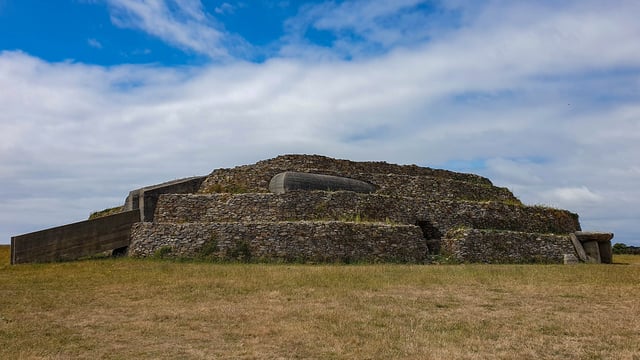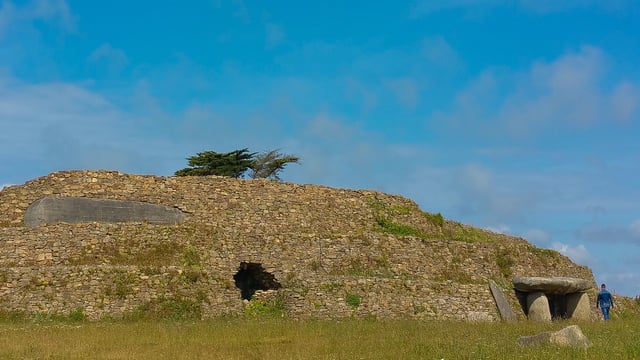The stepped cairn of le Petit Mont is thought to be one of the most significant chambered tombs in Brittany. The cairn is located on the very tip of the Rhys peninsula. This strategic location made the site vulnerable to the Nazis during World War II, who built a typical bunker into the prehistoric structure, making it part of the Atlantic Wall defences. The cairn is open to the public, including access to both the prehistoric chambers and the military bunker.
- Thomas Dowson
- Last Checked and/or Updated 15 December 2021
- No Comments
- France
As prehistoric monuments go, the decorated chambered tomb known as le Petit Mont has had an interesting history. Constructed as a funerary monument in the Neolithic site, around 6,600 years ago, it was in still in use during the Bronze Age, and even known to the Gallo-Roman communities in the area. Many centuries later in 1943, the strategic location of this 6 m high cairn on a rise in an otherwise flat landscape, at the tip of a peninsular at the mouth of the Gulf of Morbihan, made it an attractive site for a Nazi bunker as part of the Atlantic Wall. In the 1980s the site was excavated and restored under the direction of archaeologist Joël Lecornec.

Prehistoric Funerary Monument
The entire cairn measures 50 metres east-west and 53 metres north-south, with an estimated volume of stones of 10,000 cubic metres. Petit Mont chambered tomb we see today is the result of at least three different stages of construction.
The first cairn was constructed on a low mound thought to be about 6,600 years old. This early cairn, 6,500 years old, was a simple trapezoidal mound of small rocks that measured about 30 by 20 metres. The cairn was extended between 6,000 and 5,500 years ago with a simple passage and single chamber. Six of the eight megaliths making up the chamber and three of those making up the passage are decorated. Sometime between 4,700 and 4,500 years ago the cairn was expanded, which destroyed the earlier chamber. Two new single chambered passages were created; the later chambers have more engravings in them than the earlier one.
Atlantic Wall - WWII Bunker
During the second World War, in 1943 to be precise, a bunker or blockhouse was built into the cairn. The bunker was part of the extensive system of fortifications that formed the Atlantic Wall, running from Scandinavia in the north and along the north-western coast of continental Europe. Construction of the bunker destroyed the two older chambers, but facilitated the excavation of the earlier passage and its chamber.
Add Le Petit Mont to Your Itineraries & Travel Lists
If you are already planning a trip to Brittany and other areas of France, you can create your own travel lists (such as places you have been to, places you would like to visit) and an itinerary for your visit. These can also be shared with your friends and on social media. You can see how this is done by watching our Using the Itinerary video on YouTube, or reading the Using the Itinerary page.
For more ideas and suggestions, sites and museums to visit, see our Guide to the Megalithic Sites in France, our Regional Guide to Brittany, and our France Travel Guide.
Petit Mont Chambered Tomb & WWII Bunker
The cairn of Petit Mont is thought to be one of the most significant chambered tombs in Brittany. Although this is for all intents and purposes a ‘Neolithic site’, from about 6,600 years ago, it is an excellent example of how monuments constructed in one period are re-used in subsequent periods. Artefacts recovered during excavations show that this site was also in use during the Bronze Age and the Gallo-Roman period. But the most obvious evidence of re-use is the typical German bunker built into the cairn in 1943.





